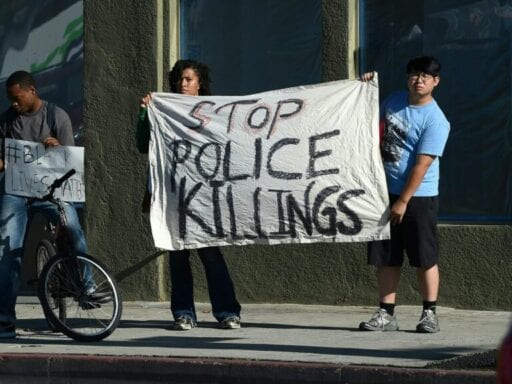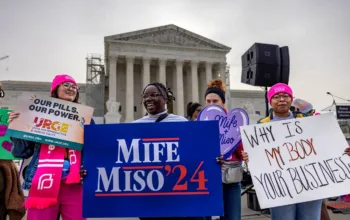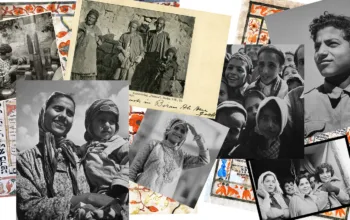A new study finds that fatal police violence is a leading cause of death for young men in America. The study’s lead author tells Vox why that matters.
The deaths of unarmed black men and boys like Eric Garner, Michael Brown, and Tamir Rice kicked off a national conversation about police violence — particularly, fatal police violence against people of color — five years ago. That attention has fueled demands for police reform and officer accountability and has also led to media and activist-led efforts to track the number of police shootings across the country.
A new study finds that this attention to police violence is increasingly important, using statistics to argue that police killings are now a leading cause of death for young men in the United States. And researchers argue that policing has become an urgent public health concern with real impacts on communities.
The study, conducted by a team of researchers from Rutgers University, the University of Michigan, and Washington University in St. Louis, was recently published in Proceedings of the National Academy of Sciences. The researchers used data from Fatal Encounters, a journalist-compiled database of fatal interactions with police, to estimate the risk of being killed in a police use of force incident based on race, age, and sex.
Using data from 2013 to 2018, they found that fatal police violence is the sixth-leading cause of death for men ages 25 to 29 across all racial groups. The study also found that the lifetime risk of dying from police violence is at its highest from ages 20 to 35, and that this applies to men and women of all races.
While young men in general face a higher risk of being killed by police violence, the level of risk changes depending on race. Young men of color — specifically black, Latino, and Native American men — face a higher risk of being killed than white men and Asian American and Pacific Islander men (though the numbers suggest that fatal police violence against white Americans is also increasing). The estimated number of killings of young black men means that roughly one in 1,000 black men face fatal police violence — a rate that is 2.5 times greater than that of white men.
The overall rate of police killings trails behind car accidents, suicides, homicide, heart disease, and cancer as a leading cause of death. “Our results show that people of color face a higher likelihood of being killed by police than do white men and women, that risk peaks in young adulthood, and that men of color face a nontrivial lifetime risk of being killed by police,” the researchers write.
The study also shows how women experience fatal police violence: While women are killed at a lower rate than men, there are still racial disparities in these deaths. Black women and Native American women, for example, are more likely to be killed by police than white, Latina, and Asian American/Pacific Islander women.
The data used in the study does not distinguish between fatal incidents that were later found to be justified uses of force and those that were not (data collected by the FBI, which is widely seen as incomplete, has found that 400 to 500 of the roughly 1,000 police shootings that occur each year are determined to be justified). Instead, the study examined how fatal police use of force more generally affects different groups.
There’s a “litany of negative consequences for health that this sort of aggressive and violent policing produces,” says Frank Edwards, the study’s lead author and an assistant professor in the School of Criminal Justice at Rutgers University-Newark. “The time has come for us to take this seriously as a cause of harm to public health.”
I spoke with Edwards about the study, why there needs to be comprehensive federal data tracking police violence, and the importance of treating police killings as a public health issue. Our conversation has been edited for length and clarity.
P.R. Lockhart
Why did you want to look at the rates of people being killed by police?
Frank Edwards
When we think of other causes of death — things like homicide, suicide, heart disease, cancer — we have really good numbers on who this affects, how often it occurs, how likely you are to die from these diseases over the course of your life. But we have no such data for police violence. We thought that we had a strong opportunity to improve how much we knew about people getting killed by police.
Police violence often gets portrayed as a problem that is exclusively concentrated on black men living in cities. And that group is disproportionately affected, our research shows that clearly. But there are other groups affected, and incidence of police violence is pretty widespread.
But there weren’t baseline numbers about how often this was occurring. We felt that the availability of unofficial databases like the Fatal Encounters database (which uses a combination of paid researchers, public records requests, and crowdsourced data to track fatal police violence) made the analysis possible — the federal government has failed to produce reliable numbers.
P.R. Lockhart
What are the biggest takeaways of the study?
Frank Edwards
Police violence is incredibly common. We find that among all men in the US, they face about a 1 in 2,000 odds of being killed by police over the course of their lives.
For white men, it’s about a 1 in 2,500 risk of being killed by police, but when we look at black men it is every 1 in 1,000. That means that for every 1,000 black boys born in this country, if the risk of police killings stays where it has been over the past five years, then we expect one of those boys to be killed by police at some point of their life.
We think that’s a really striking — and high — number.
/cdn.vox-cdn.com/uploads/chorus_asset/file/18969445/GarnerPoliceViolenceProtest.jpg) Spencer Platt/Getty Images
Spencer Platt/Getty ImagesWomen have a risk as well, it’s about 1 in 33,000 compared to 1 in 2,000 for men. But women still have a risk, and when we look at this further you see that women being killed by police is also unequal across racial and ethnic groups. Black women and Native American women are about 1.5 times more likely than white women to be killed by police.
Our study is really one of the first to provide detailed estimates of the risk faced by Asian American and Pacific Islanders, Native Americans, and Latinos and Latinas, across age and race.
I would say that there are a few big takeaways: one, that lifetime risk of fatal police violence, especially for men, is unequal across racial and ethnic groups — people of color are much more likely to be killed by police than white people. The risk of being killed by police is concentrated among the young; from the ages of 20 to 35, and for young men from the peak ages of 25 to 29, police violence is a significant contributor to overall mortality, especially for young men of color. Of all the men who die between the ages of 20 and 29, police are responsible for more than 1 percent of those deaths.
P.R. Lockhart
In the paper, you and your co-authors argue that police violence needs to be looked at as a public health issue. Can you talk to me about why that matters?
Frank Edwards
We think that the research community has provided ample evidence that the way police operate is harmful to both individual and community health. Think about all the ways that policing affects communities that are less extreme than a killing.
A police killing affects more than the deceased. There’s been great research finding that when an unarmed African American man is killed in a state, there is an increase in symptoms of depression among African Americans in that state following the shooting. When a white unarmed man is killed in a state, there’s no similar increase in depressive symptoms among white residents. It strongly suggests that black people see police as a distinctive threat to their well-being, and they — I would argue rightly — perceive police as dangerous. It increases their feelings of outsidership, their feelings of dehumanization, and it increases fear in their interactions with police.
We also know that with policies like stop-and-frisk in New York City, where police aggressively target young men of color, and other policies in other areas as well, the young men who go through this and experience physical searches have increases in PTSD symptoms afterwards. They become hypervigilant, and that can have all sorts of cascading negative health consequences as you’re inducing these chronic stresses on relatively young people.
Heavily policed neighborhoods also see increases in anxiety, as people are fearful and they deal with the sorts of chronic stress that we know can be especially toxic. The research community has documented a litany of negative consequences for health that this sort of aggressive and violent policing produces. The time has come for us to take this seriously as a cause of harm to public health and something that is particularly expanding health inequality among racial groups.
It’s particularly harming young African American men, but you look at the tragic cases of women like Erica Garner who are exposed to these deaths, and you see how it has an incredible toll on well-being that can lead to early mortality. We think the time is long past for the medical community and health community to not only identify these issues but design interventions that can help.
P.R. Lockhart
Any thoughts on what those possible interventions could look like?
Frank Edwards
As other researchers have examined, this is likely a problem of policing becoming a sort of catchall solution to every single problem that our society has. We’ve defunded services that give people alternatives to calling the police when there is a crisis. The defunding of mental health clinics and other kinds of social services means that officers take on these routine roles of responding to problems.
When you talk to police officers, they will tell you that they are not mental health professionals, they’re not social workers, and that many of the things they are tasked with dealing with they’re not trained for and aren’t equipped to deal with.
In the paper, we don’t look into particular interventions, our recommendations are based on other research. But we think adequately funding community-based services would almost certainly help reduce violence by providing communities with tools and alternatives to police.
Another issue is that we don’t have official data on policing, and the data we do have is from journalists, not the government itself. We rely on the media, and in my mind it is unacceptable to need them to provide this basic public service and this basic check on police abuse of power.
I’m optimistic that we will get more robust data from the federal government, and universities and nonprofits are building data tracking projects, so hopefully this is a problem that will be solved. But data is essential for building out systems for the public to be able to hold police accountable.
/cdn.vox-cdn.com/uploads/chorus_asset/file/18969584/MilwaukeePoliceProtest.jpg) Armando L. Sanchez/Chicago Tribune/TNS via Getty Images
Armando L. Sanchez/Chicago Tribune/TNS via Getty ImagesP.R. Lockhart
With this study, you’ve said that you wanted to answer a basic question about how likely different demographics are to face fatal police violence. After looking at that, are there other questions about police violence you want to look at in future research?
Frank Edwards
There are a million things — we’re excited and depressed by how much has been unanswered about police violence. A lot of the current research has looked at how much of the issue is due to racism, and we think that is the wrong question to be asking. When you look at these inequalities, it is clear that both structural racism and discrimination in the pattern and practice of policing has to be occurring. We don’t see these levels of violence without disparities and distinctions in how communities of color are policed, and a history of segregation and disinvestment in communities of color, especially cities.
The things that my team is looking at next is the role mental illness and disabilities play in shaping interactions with police, particularly how often people struggling with mental illness, addictions, and physical disabilities interact with and are killed by police. This strikes us as a population where there are easy alternatives to imagine in terms of using police as a form of crisis response.
Traffic is another big area to research. This current study does not look at vehicular deaths, but a lot of people die during high-speed police chases, whether that’s civilians involved in collisions during these chases or the suspect driving the car. We don’t know a lot about why that is and where that is happening. But we do know that if we include those deaths in the lifetime risk of being killed, the numbers go up a lot, especially for women.
We also want to look at how different police agencies respond to incidents. There’s a lot to be looked with how different police departments and municipalities are shaping risk in certain regions and communities. We’re finding that in some regions 15 to 17 percent of all deaths are caused by police. That strikes us as extreme and deserving of more attention.
Author: P.R. Lockhart
Read More



